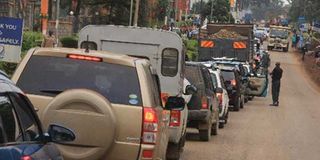Our driving habits are an insult to common sense

Observing the Highway Code does not require good memory; just good manners. So our current driving culture is not just a systems failure – it is an affront to common courtesy and common sense. PHOTO/FILE
What you need to know:
- Even if nobody teaches or tests you, how long does it take to work out that overtaking on a blind brow or bend is dangerous; that beam headlamps dazzle; that barging into queues is rude; that weaving between lanes is disruptive to flow...?
- Driving into Nairobi is like going to a music concert... and watching the orchestra smash their instruments over each other’s heads.
The list of common mistakes made by drivers in Kenya is not short.
Six out of every 10 make at least three mistakes that would fail a driving test (which is designed to be easy enough for beginners) on every trip!
That’s a damning indictment of our driving tuition, examination and enforcement standards. But it’s worse than that. For driving is not so much taught through lessons as learned through practice and logic.
Observing the Highway Code does not require good memory; just good manners. So our current driving culture is not just a systems failure – it is an affront to common courtesy and common sense.
Even if nobody teaches or tests you, how long does it take to work out that overtaking on a blind brow or bend is dangerous; that beam headlamps dazzle; that barging into queues is rude; that weaving between lanes is disruptive to flow...?
Surely, every motorist realises how annoying it is if another vehicle pulls alongside at a T junction and blocks your vision in one direction; or an oncoming vehicle that plans to turn left into your junction does not indicate that intention, so you wait needlessly.
Surely it’s a no-brainer to work out, and remember, what to do and what not to do in these and dozens of other situations.
ORCHESTRA OF CHAOS
Even relatively sophisticated details, like dipping headlights before you dazzle (i.e. when there’s a “halo” at the brow or bend rather than at the eyeball-to-eyeball stage), and that oncoming lights are more dazzling to drivers on right-hand bends than left-hand bends, are not eureka discoveries.
They would be obvious even to a half-witted amoeba’s senile great grandmother.
And yet, on any short journey you will see several vehicles turn without indicating, indicate without turning, or grapple with that most vexing scientific distinction – the difference between left and right.
You will see drivers blocking others (and themselves!) by jamming their way into clogged box junctions; you will see vehicles taking the “short” queue even when that means slicing across lanes at a roundabout to take the direction they want.
Driving into Nairobi is like going to a music concert... and watching the orchestra smash their instruments over each other’s heads.
It’s a situation that fully warrants the longest word in the English language: Flocipaucinihilipillification. Worthless, the act of deeming as.
The journey back to the path of orderly conduct will be long and complex. But it must begin with one step. Which one?
Finding and acting on that answer is the biggest challenge for road traffic administrators. But to have any chance of getting the right answer, they have to ask the right question. Any sign of that so far?





